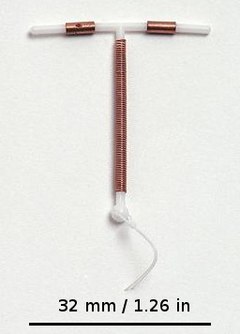| Mr. Ibrahem/Copper IUDs | |
|---|---|
 Photo of a common IUD (Paragard T 380A) | |
| Background | |
| Type | Long-acting reversible birth control (LARC)[1] |
| First use | 1970s[2] |
| Trade names | Copper-T, ParaGard, others |
| AHFS/Drugs.com | FDA Professional Drug Information |
| Failure rates (first year) | |
| Perfect use | 0.6%[3] |
| Typical use | 0.8%[3] |
| Usage | |
| Duration effect | 10–15 years[1] |
| Reversibility | Rapid[2] |
| User reminders | Signs of expulsion[1] |
| Clinic review | No routine follow-up[1] |
| Advantages and disadvantages | |
| STI protection | No[4] |
| Periods | May be heavier or more painful[5] |
| Benefits | No daily action Emergency birth control if used within 5 to 10 days[6] |
| Risks | Possible mall risk of PID in first 20 days[1][5] Uterine perforation (rare)[6] |
Copper intrauterine device, also known as intrauterine device (IUD) with copper and intrauterine coil, is a type of intrauterine device which contains copper.[5] It is used for birth control and emergency contraception within five days of unprotected sex.[5] It is one of the most effective forms of birth control with a one-year failure rate around 0.7%.[7] The device is placed in the uterus and lasts up to twelve years.[5][2][8] It may be used by women of all ages regardless of whether or not they have had children.[9] Following removal, fertility quickly returns.[2]
Side effects include heavy menstrual periods, painful periods, or the device may come out.[5] It is less recommended in people at high risk of sexually transmitted infections as it may increase the risk of pelvic inflammatory disease in the first three weeks after insertion.[9] If a woman becomes pregnant with an IUD in place removal is recommended.[9] Rarely, uterine perforation can occur during insertion.[2] The copper IUD is a type of long-acting reversible birth control.[7] It primarily works by killing the sperm.[2]
The copper IUD came into medical use in the 1970s.[2] It is on the World Health Organization's List of Essential Medicines.[10] The wholesale cost in the developing world is about US$0.40–3.00 per IUD.[11] In the United Kingdom they cost the NHS about £10 GBP.[9] In Canada they costs about 80 CAD as of 2021.[12] In the United States they cost around $750.[13] They are used by more than 170 million women globally.[14][15]
References edit
- ^ a b c d e Baker, CC; Creinin, MD (1 November 2022). "Long-Acting Reversible Contraception". Obstetrics and gynecology. 140 (5): 883–897. doi:10.1097/AOG.0000000000004967. PMID 36201766.
- ^ a b c d e f g Goodwin, T. Murphy; Montoro, Martin N.; Muderspach, Laila; Paulson, Richard; Roy, Subir (2010). Management of Common Problems in Obstetrics and Gynecology (5 ed.). John Wiley & Sons. pp. 494–496. ISBN 978-1-4443-9034-6. Archived from the original on 2017-11-05.
- ^ a b Trussell, James (2011). "Contraceptive efficacy" (PDF). In Hatcher, Robert A.; Trussell, James; Nelson, Anita L.; Cates, Willard Jr.; Kowal, Deborah; Policar, Michael S. (eds.). Contraceptive technology (20th revised ed.). New York: Ardent Media. pp. 779–863. ISBN 978-1-59708-004-0. ISSN 0091-9721. OCLC 781956734. Archived (PDF) from the original on 2017-02-15.
- ^ "What Are the Side Effects & Complications of the IUD?". www.plannedparenthood.org. Archived from the original on 1 December 2017. Retrieved 13 July 2023.
- ^ a b c d e f World Health Organization (2009). Stuart MC, Kouimtzi M, Hill SR (eds.). WHO Model Formulary 2008. World Health Organization. pp. 370–2. hdl:10665/44053. ISBN 9789241547659.
- ^ a b "Emergency Contraception". www.acog.org. Archived from the original on 2020-06-22. Retrieved 2020-06-18.
- ^ a b Wipf, Joyce (2015). Women's Health, An Issue of Medical Clinics of North America. Elsevier Health Sciences. p. 507. ISBN 978-0-323-37608-2. Archived from the original on 2017-09-24.
- ^ "IUD Birth Control Info About Mirena & ParaGard IUDs". www.plannedparenthood.org. Archived from the original on 4 January 2021. Retrieved 22 March 2018.
- ^ a b c d British national formulary : BNF 69 (69 ed.). British Medical Association. 2015. pp. 557–559. ISBN 978-0-85711-156-2.
- ^ World Health Organization (2019). World Health Organization model list of essential medicines: 21st list 2019. Geneva: World Health Organization. hdl:10665/325771. WHO/MVP/EMP/IAU/2019.06. License: CC BY-NC-SA 3.0 IGO.
- ^ "Iud (Copper)". International Drug Price Indicator Guide. Archived from the original on 12 July 2020. Retrieved 8 December 2016.
- ^ Ton, Joey (6 February 2022). "#308 Can It Stay or Must It Go? Extended Use of Intrauterine Devices". CFPCLearn. Archived from the original on 28 March 2023. Retrieved 14 June 2023.
- ^ Zieman, Mimi (2012). Managing Contraception 2012–2014. Managing Contraception. p. Chapter 27. ISBN 978-1-4675-3640-0. Archived from the original on 2017-11-05.
- ^ Speroff, Leon; Darney, Philip D. (2011). A Clinical Guide for Contraception. Lippincott Williams & Wilkins. p. 243. ISBN 978-1-60831-610-6. Archived from the original on 2017-11-05.
- ^ Schäfer-Korting, Monika (2010). Drug Delivery. Springer Science & Business Media. p. 290. ISBN 978-3-642-00477-3. Archived from the original on 2017-11-05.